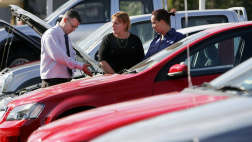Some, like the latest Rinspeed Squba, are brilliant examples of fearless technology and design. Others, like the trans-Atlantic jeep “Half-Safe”, uphold the extreme daring of man.
Then there are amphibians engineered purely to overcome any obstacle — vehicles such as Ferdinand Porsche's Volkswagen Schwimmwagen lived a brief life in World War II.
So harsh was the environment of war that, of the 15,000 built in two years, only about 125 survive. Its war-time lifespan was only six weeks.
This example was recently spotted in a shed on the property of farmer and Maserati collector Umberto Panini, near Modena in Italy. It was tucked away along with other rare — and now extremely valuable — wartime vehicles, not far from a more glamorous museum housing the Maseratis.
The Schwimmwagen, known during the war as Type 166, was an all-wheel-drive amphibian built on a shortened platform that was later used for the first production VW Beetle of 1948.
It was the third amphibious vehicle design presented by Porsche in answer to the German army's call for a vehicle that could traverse mud, snow, sand and water.
Volkswagen built 30 original Type 128s in 1941. The boat-shaped body was approved by the German army, but needed further development, leading to the Type 138, of which 100 were built.
But Porsche was unhappy with the stability and size of these two, and
so offered a shorter and narrower Type166 in late 1941.
The 166 entered full-scale production at Volkswagen's factory in Wolfsburg, using parts from other VW military vehicles, notably the canvas-roofed four-seater Kubelwagen.
Like the later Kubelwagen, the Schwimmwagen had the “bigger” 18.6kW 1131cc (previous models had a 985cc unit), four-cylinder, air-cooled engine. It had part-time 4WD, a crawler gear for low-speed work, four non-synchromesh forward gears and changeable gears in the rear wheels' reduction hubs.
Its central oiling system was a simple one-press device activated by the driver after a water dip.
In the water, the engine drove a three-blade propeller. This was hinged down by a long rod to engage a claw drive at the back of the engine. Steering was by the front wheels.
Production of the Schwimmwagen stopped in 1944 because of the very high man-hours needed to build
the craft and the high cost of materials.
While it had an average lifespan of six weeks in action, which quickly depleted supply, those that survived were used after the war by civil services of the countries that found the vehicles.
The Panini version is a complete example, including the tripod for guns, two wooden oars (for quiet mobility on water), the simple canvas seats, rare 16-inch tyres and the sand-coloured paintwork.
More at www.vw166.com
Snapshot
VW Schwimmwagen
origin: 15,125 built in Germany in1942-44; 125 survive
engine: 1.1L/4-cyl, 18.6kW
top speed: 80km/h land, 10km/h water
economy: 8.5L/100km
transmission: 4-speed manual, non-synchromesh





.jpg)

.jpg)

.jpg)

.jpg)
.jpg)

.jpg)





.jpg)

.jpg)

_0.jpg)

.jpg)
.jpg)




